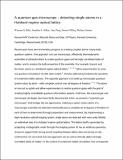| dc.contributor.author | Bakr, Waseem Sulaiman | |
| dc.contributor.author | Gillen, Jonathon | |
| dc.contributor.author | Peng, Amy Wan-Chih | |
| dc.contributor.author | Fölling, Simon | |
| dc.contributor.author | Greiner, Markus | |
| dc.date.accessioned | 2011-02-04T20:51:28Z | |
| dc.date.issued | 2009 | |
| dc.identifier.citation | Bakr, Waseem Sulaiman, Jonathon I. Gillen, Amy Wan-Chih Peng, Simon Fölling, and Markus Greiner. 2009. A quantum gas microscope for detecting single atoms in a Hubbard-regime optical lattice. Nature 462(7269): 74-77. | en_US |
| dc.identifier.issn | 0028-0836 | en_US |
| dc.identifier.uri | http://nrs.harvard.edu/urn-3:HUL.InstRepos:4703994 | |
| dc.description.abstract | Recent years have seen tremendous progress in creating complex atomic many-body quantum systems. One approach is to use macroscopic, effectively thermodynamic ensembles of ultracold atoms to create quantum gases and strongly correlated states of matter, and to analyze the bulk properties of the ensemble. For example, bosonic and fermionic atoms in a Hubbard regime optical lattice 1, 2, 3, 4, 5 allow experimenters to carry out quantum simulations of solid state models 6, thereby addressing fundamental questions of condensed matter physics. The opposite approach is to build up microscopic quantum systems atom by atom – with complete control over all degrees of freedom 7, 8, 9. The atoms or ions act as qubits and allow experimenters to realize quantum gates with the goal of creating highly controllable quantum information systems. Until now, the macroscopic and microscopic strategies have been fairly disconnected. Here, we present a “quantum gas microscope” that bridges the two approaches, realizing a system where atoms of a macroscopic ensemble are detected individually and a complete set of degrees of freedom of each of them is determined through preparation and measurement. By implementing a high-resolution optical imaging system, single atoms are detected with near-unity fidelity on individual sites of a Hubbard regime optical lattice. The lattice itself is generated by projecting a holographic mask through the imaging system. It has an arbitrary geometry, chosen to support both strong tunnel coupling between lattice sites and strong on-site
confinement. On one hand, this new approach can be used to directly detect strongly correlated states of matter. In the context of condensed matter simulation, this corresponds to the detection of individual electrons in the simulated crystal with atomic resolution. On
the other hand, the quantum gas microscope opens the door for the addressing and readout of large-scale quantum information systems with ultracold atoms. | en_US |
| dc.description.sponsorship | Physics | en_US |
| dc.language.iso | en_US | en_US |
| dc.publisher | Nature Publishing Group | en_US |
| dc.relation.isversionof | doi:10.1038/nature08482 | en_US |
| dash.license | OAP | |
| dc.title | A Quantum Gas Microscope for Detecting Single Atoms in a Hubbard-Regime Optical Lattice | en_US |
| dc.type | Journal Article | en_US |
| dc.description.version | Author's Original | en_US |
| dc.relation.journal | Nature | en_US |
| dash.depositing.author | Greiner, Markus | |
| dc.date.available | 2011-02-04T20:51:28Z | |
| dc.identifier.doi | 10.1038/nature08482 | * |
| dash.authorsordered | false | |
| dash.contributor.affiliated | Peng, Amy Wan-Chih | |
| dash.contributor.affiliated | Bakr, Waseem Sulaiman | |
| dash.contributor.affiliated | Greiner, Markus | |


